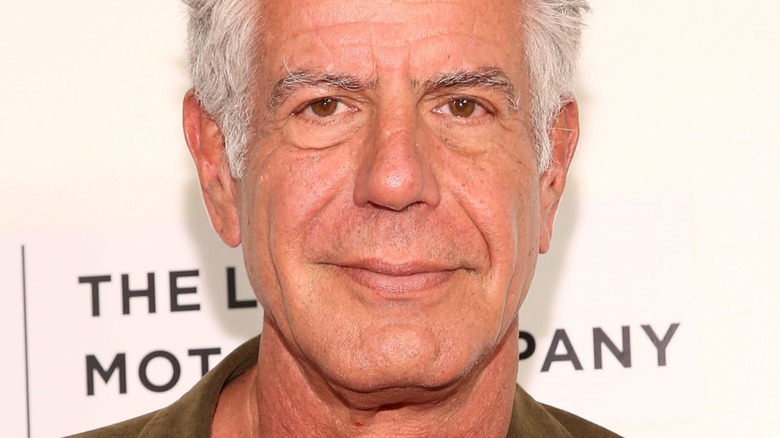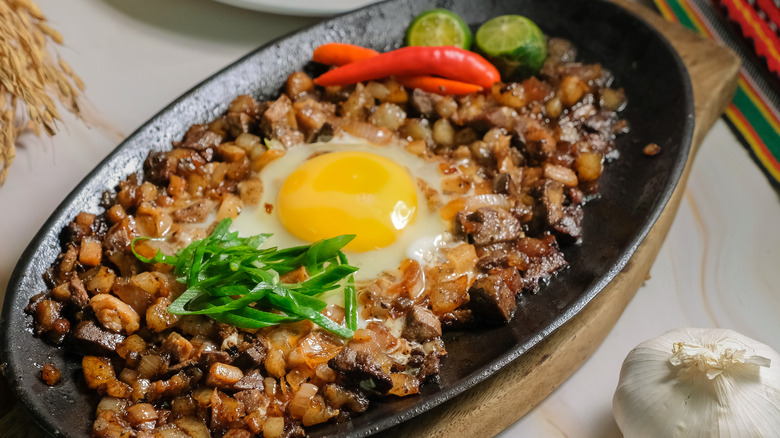The Filipino Dish Anthony Bourdain Believed Would Be A Major Trend
Even years after his untimely death, it is still clear that Anthony Bourdain changed the way people looked at food. He created a willingness in food-loving fans to be like Tony, and just try something new. His influence is obvious in the way diners and restaurateurs alike talk about food, and before long, Bourdain's favorite dishes quickly became hits back home, describes Forbes. It is no accident that following his 2002 trip to Vietnam, pho stepped into the limelight back in the United States. Similarly, his excitement for Japanese culture likely contributed to the ramen craze seen in fine dining restaurants across the country. His nuanced appreciation for street food and ability to craftily call out high-end trends showed a deep understanding of food and of culture more broadly.
Of course, Bourdain's hot takes were all packaged in his trademarked wit. In a segment on the Tonight Show with Jimmy Fallon, Anthony Bourdain was asked to give his opinion on some popular food trends of the moment (via YouTube). When discussing truffle oil, he described it as "horrible" and "not even food." Unsurprisingly, like pretty much every line cook, Bourdain again proclaimed his hatred for brunch. Kobe beef sliders, however, Bourdain declared were the worst of the lineup saying that if a restaurant you go to has them on the menu, it is better to just turn around and leave. However, the trendsetter did think one Filipino dish was bound to gain popularity.
Anthony Bourdain believed the Filipino dish sisig would be the next big thing
Forbes also notes Anthony Bourdain's love for eating all parts of the animal provided fuel for the nose-to-tail cooking movement, as well. In a post on his Tumblr, Bourdain describes how various important dishes in iconic culinary traditions across the world "began with the urgent need to make something good and reasonably sustaining out of very little." He cites how the Italians, French, Chinese, Indians, and Portuguese took budget-friendly cuts and turned them into something delicious.
It is with this same understanding that Bourdain lauds the Filipino dish sisig in an interview with CNN Philippines. Sisig was originally known to be a sour, citrusy, savory, salad typically eaten as a side dish, according to Unilever Food Solutions. It wasn't until after the American occupation that off-cuts of pork, organs, and pig head began to be incorporated into the dish. These parts were not used in meals prepared for the U.S. troops and nearby restaurants began to use the would-be waste in sisig. Alongside a cold beer, the dish became very popular with railroad workers in search of a late-night meal.
Sisig has evolved with the times, but remains delicious and accessible
Aling Lucing Cunanan is credited for creating the version of sisig that is most widely known today (via Unilever Food Solutions). In her restaurant in the 1970s, she added ingredients like "vinegar, calamansi juice, onions and liver," but most notably, she served her sisig on a sizzling hot platter, allowing the tangy bits of meat to crisp and caramelize right in front of the diner's eyes. Often topped with an egg, this quickly became the norm for how sisig was served and is the version that Anthony Bourdain fell in love with. He called it "casual, accessible, [and] exactly what you need after a few beers" (via CNN Philippines ). He went on to describe Filipino food as "underrated," and he believes sisig is the perfect food to pique the interests of those interested in Filipino food, but simply unfamiliar with it.
The New York Times reported on the rise of Filipino food in the United States, highlighting dishes that are becoming more common like lumpia, adobo, and sinigang. With 7,100 islands making up the country, the amount of regional expressions of Filipino food is dizzying. More and more restaurants showcasing this cuisine are popping up across the United States. It looks like Bourdain's wish that "sisig will win the hearts and minds of the world" is starting to come true, per CNN Phillipines.


